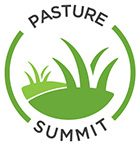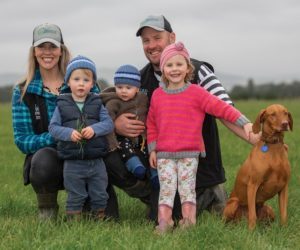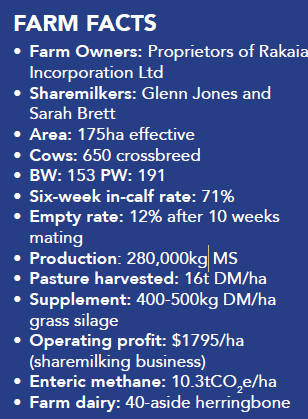Canterbury sharemilkers Glenn Jones and Sarah Brett are embracing sustainability while making a profit. Anne Lee reports. Photos by Johnny Houston.
Operating an environmentally sustainable and progressive dairy business energises and sparks excitement for Glenn Jones and Sarah Brett.
The Canterbury sharemilkers and newly minted equity partnership farm owners are enthusiastically looking forward to the future and aren’t deflated by what some can see as a myriad of challenges.

“We need to embrace these challenges and weave them into the way we farm and to continue to do what we love,” Glenn says.
The pair brought their effervescent drive to the fore when they spoke at last month’s Pasture Summit, which was held simultaneously in Ireland and New Zealand and was also livestreamed to more than 150 viewers worldwide.
Cutting nitrogen loss from grazed farm systems is a challenge faced in both countries.
“Purchased nitrogen surplus is easy to calculate and strongly correlated to N leaching. The biggest way to reduce it is to reduce nitrogen fertiliser and supplement use – so the future is grass,” Glenn says.
Managing pasture well, hitting residuals and getting stocking rate right have to be part of a farm’s DNA so that pasture eaten is lifted to push profitability while addressing environmental challenges, he says.
The couple are strong advocates that when it comes to achieving profitability and sustainability goals, one doesn’t have to come at the expense of the other.
“A profitable system allows us to be sustainable and exceed our environmental targets.
“If you’re profitable you have options – whether that’s being able to afford payments in an emissions trading scheme (ETS) or making changes in your system.
‘The biggest way to reduce it (N) is to reduce nitrogen fertiliser and supplement use – so the future is grass.’
“We’re benchmarking against ourselves and others all the time – looking at how our own KPI’s (key performance indicators) are tracking from year to year to make sure they’re going in the right direction and seeing where we sit against others.
“We’re using DairyBase and we’re also in a discussion group of likeminded sharemilkers where we share a lot of information and we’ve got a close circle of top farmers who are open and happy to get into the numbers.
“Benchmarking that way is really very powerful because you can see the areas you need to improve on.
“It gets us asking questions so we go in behind the numbers and find out how they’re achieving their results – you’re learning all the time – it’s very motivating,” he says.
When you’re setting budgets and targets – whether they’re financial or physical – monitoring those budgets, learning and taking action, you’re in the driver’s seat.
The pair came to dairying in their late 20’s.
Although Glenn’s dad and now deceased mum were dairy farmers Glenn was more interested in having a team of dogs and getting out into wider spaces so, when he completed his Bachelor of Agricultural Commerce majoring in farm management at Lincoln University, he headed off overseas to Canada.
It wasn’t until he’d been back home for a while that he realised the high-country life wasn’t going to propel him towards goals of farm ownership fast enough.
He looked to dairying and made a list of people with good reputations that he’d want to work for, people he could learn from.
Then he started knocking on doors.
He secured a job with Camden Group – owned by the Donkers family – happy to go in as a dairy assistant but with a determined eye on climbing the ranks quickly.
In six months, he was 2IC on the group’s 1050-cow Willsden Farm and within a year was managing their 650-cow, Camden Farm.
He’d met Sarah a little earlier while she was home from her OE in London where she was nursing and it was while at Camden she joined him.
‘BRIGHT’ FUTURE FOR PASTURE-BASED DAIRYING
Sarah sees a “fantastically bright” future for pasture-based dairying in NZ regardless of regulation and environmental challenge.
The opportunities to forge new pathways using NZ’s natural advantages and the myriad of new science and innovation are exciting, she says.
During the four years they spent with Camden Group Glenn sharpened not only his practical onfarm skills, he also honed his financial skills.
“They gave us exposure to the business so I was involved in the budgets and could see how we were going through the season by looking at the variance reports.
“I knew what things cost – I could see the effect on the finances of what we were doing onfarm and Leo and Terry were always open to me asking questions, wanting to learn.”
By 2017 the couple were ready for their next steps and the 50/50 sharemilking job at Rakaia Incorporation’s 650-cow, 175ha Te Pirita farm came onto their radar.
“It was a tough interview process, but we got the job,” Sarah says.
From a short list of CV’s, a small number of candidates were selected with each going on a farm walk as part of the interview process.
Each candidate then had to present a report to the farming company’s board to show what their plan would be to enable the farm to win the Ahuwhenua Trophy competition.
The couple had been buying calves and trading stock, making the very most of an opportunity to rear animals but not pay the grazing costs until the animals were sold. They took up any other staff’s calf rearing opportunity if they didn’t want it and pushed hard to make the most of the opportunity. By the time they secured the sharemilking job they had about 300 cows leased out. Now in their fifth season they’ve already ticked off big goals for both their own business and their farm owner’s.
On June 1 they took over a 1100 cow farm near Methven which they have bought with six others as an equity partnership.
They’ve remained in their sharemilking job and one of their partners has taken the equity manager role.
Four of the partners are first time owners while three are more established farmers.
FOCUSED ON THEIR FAMILY
Sarah and Glenn had previously spent time on strategic planning.
They’re very focused on their ‘why’ – their family – and have written down their goals, their values and farming philosophies.
Sarah says it’s a document they referred to when they were considering who to partner with and one they look to whenever they’re evaluating any opportunity.
Over the last two years they’ve put in four offers on farms with their partners.
Glenn has focused on the due diligence work so the group could fully understand what the farm’s potential opportunities and challenges could be.
Environmental targets, possible infrastructure upgrades, consent conditions and water were big parts of that due diligence and had to be factored into any price offers. They had to be prepared to walk away if their price wasn’t accepted and that’s where the wise heads of their established farmer partners helped.
“You just had to take the emotion out of it but we’re there now,” Glenn says.
They have high expectations for the farm’s financial and environmental performance too. The pre-purchase work, great communication and alignment among the shareholders, not to mention the calibre of the people involved give it the best chance of achieving its goals.
Glenn says having the governance well set up in advance is imperative and he’s enjoyed learning more about that aspect of the business.
Their sharemilking job is returning results for them and their farm owners
CUTTING N LOSS
The Te Pirita farm is in the Selwyn/Te Waihora zone.
By January next year dairy farms inthat zone must cut nitrate loss by 30% from their baseline loss figure (the average of their annual losses from 2009 – 2013).
They’ve already achieved that with a 38% drop thanks, in part, to a change in 2017/18 from Rotorainers to pivot and fixed grid irrigators and closely managed irrigation application using soil moisture monitoring.
Their water comes from the Central Plains Water irrigation scheme which is more expensive relative to many other, older schemes, making water use efficiency not just an environmental but a financial imperative too.
Their share of irrigation costs is $473/ha compared with the benchmark for sharemilkers in the region of $211/ha.
They’ve had an approved, audited farm environment plan for the past five years and are Synlait Lead with Pride Gold Plus accredited.
Best practice is business as usual.
Glenn says they’ve been reducing their nitrogen application rates over the past few years and will comfortably come in under the 190kg N/ha cap this season.
They have a nitrogen fertiliser plan set up before each season and don’t simply follow the cows.
The first application goes on as ammonium sulphate with nothing applied until the soil temperature is over 7 deg Celsius and rising.
The March application also goes on as ammonium sulphate.
The effluent areas receive lower rates of nitrogen and the GPS controlled spreading equipment on precision applicator trucks means the fronts of paddocks where cows gather near the gate also get treated like effluent areas.
In January and February, when hotter temperatures reduce the response rates, the effluent areas get no or very reduced rates of urea and the rest of the farm gets just one application.
The farm has a grass fed contract with Synlait and uses up to 500kg/cow of bought-in pasture silage – 1/3 fed through spring and 2/3 fed over autumn.
Through April, cows are transitioned onto fodder grown on the milking platform.
GETTING THE MOST OUT OF PASTURE
Maximising pasture harvested is a key way to boost profit while bringing down nitrogen loss if stocking rate can remain steady and production improves.
“We’re still feeding the same amount of supplement as we were in the first year but we’re producing 34,000kg milk solids because we’re growing and harvesting more higher quality pasture, using newer cultivars that are giving us a better response to nitrogen.”
They’ve been re-grassing up to 20% of the farm a year and will be able to cut that back in the future as most of the farm is in improved pasture.
They’ve used a “double cropping” method to help get rid of persistent older species by spraying out and direct drilling a shorter-term Italian tetraploid ryegrass, Shogun.
It’s quick to establish and has high growth rates from the get go, especially the cooler months.
Those paddocks are then sprayed out and cultivated with a permanent diploid/tetraploid mix sown along with 4kg of two clover cultivars.
Clover content is strengthening in the sward as nitrogen fertiliser levels drop.
The spring rotation planner is strictly adhered to with all staff part of the pre-season planning meetings to ensure everyone is on the same page.
When it comes to people, Glenn and Sarah say their wages bill is higher than the benchmark average.
“Some of that is the nature of the farm with two herds going through a 40-aside herringbone with no automation,” Glenn says.
They put the effort into training quality people and expect a return on that investment with cows well looked after, attention paid to detail and everyone capable of tasks such as loading and operating the feed out wagon, allocating feed and treating cows.
“We want to be employers of choice and we work on building our brand,” Sarah says.
It’s working – they haven’t had to advertise for staff with people instead contacting them.
UNDERSTANDING GHG EMISSIONS
Understanding greenhouse gas (GHG) emissions goes a long way to relieving anxiety about the issue, Glenn says.
“The key thing is to know what your number is and look at where they (the emissions) are coming from.
“Our enteric methane is 10.3tCO2 equivalent/ha based on the 2019/20 season and the benchmark Canterbury average is 11.3 so we’re sitting on the right side of that.”
Methane emissions are highly correlated to feed intake so having efficient converters of feed to milk is important.
Again, having the data to make breeding decisions is essential to that so they herd test four times a year and G3 DNA Profile calves and weigh heifers coming into the herd. Continuing to limit bought-in supplement, manage pasture well and focus on maintaining or increasing profit will help push them further into the high-profit, low-emissions quadrant of the equation.
“Reducing our nitrogen losses and managing nitrogen fertiliser better pushes down nitrous oxide emissions.
“We might not be able to move our methane emissions profile much with the current technology but we can make sure we’re at the lower end of the benchmark group and keep profit up there.
“It’s like everything – if you measure it and monitor it you can manage it.
“You have to be learning all the time, actively asking questions – there are opportunities when you look,” he says.
Check out @Watertonagricultural on Instagram and Facebook





